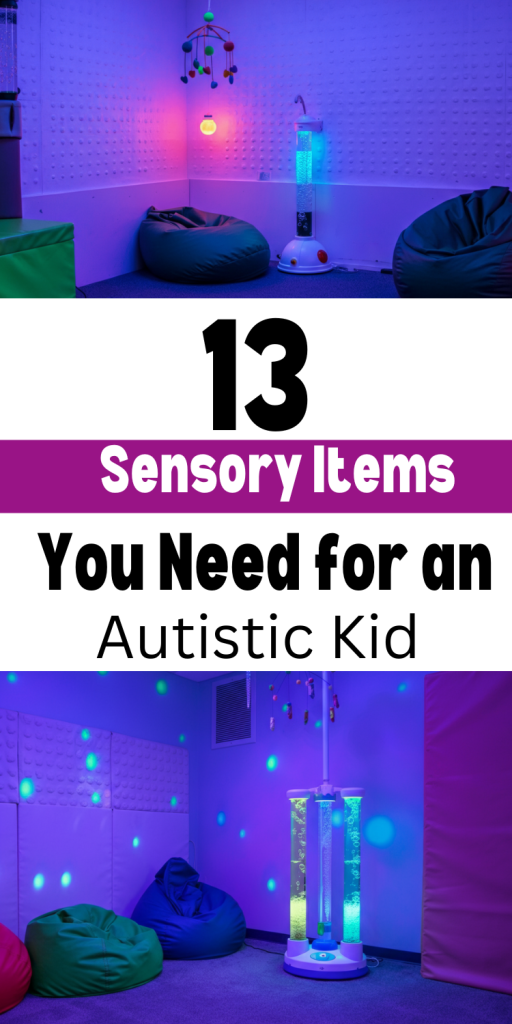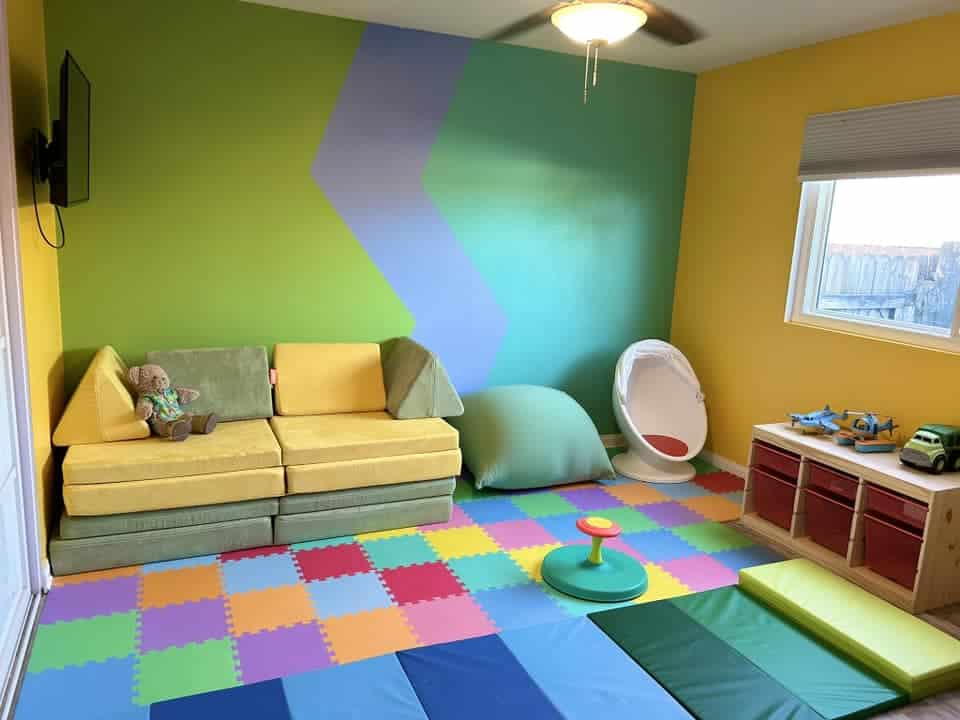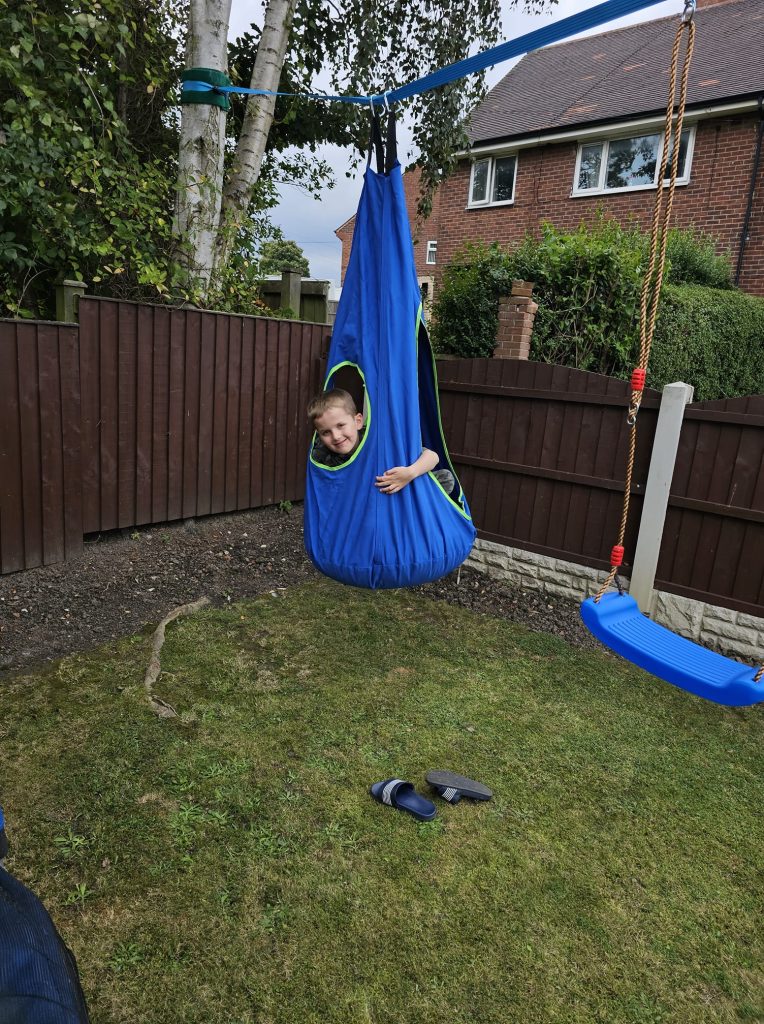Let’s face it — when you’ve got little ones in the house, whether they have sensory needs or not, you’ll definitely need a few sensory toys or accessories here and there. Because honestly, these kids have energy levels that could power a small city ?.
Now, if your child is on the autism spectrum or has sensory processing challenges, those sensory tools become even more important. A sensory room can be a total game-changer — a cozy, safe spot where your child can calm down, explore textures, or just be themselves without feeling overwhelmed.

When setting up a sensory room, it’s all about being intentional — picking the right items that match your child’s specific needs and personality. In this post, I’ll walk you through some must-haves that make a real difference — things like sensory boards, mats, climbing holds, trampolines, body socks, and a few other gems that help create that perfect sensory haven.
- Soft Furnishings
If there’s one thing I’ve learned, it’s that comfort sets the tone for everything. You can’t expect your little one to explore or calm down if the space feels cold or stiff. Start with the basics — soft, squishy, and cozy. Think bean bags they can sink into, big floor cushions for rolling around, and plush rugs that just invite bare feet.
These soft spots don’t just make the room look pretty — they make your child feel safe. It’s where they can flop down after a big sensory moment, relax, and take things in at their own pace. Because sometimes, the best therapy happens when they’re simply curled up in their favorite corner, feeling calm and secure.

- Sensory Lighting
Lighting can completely change the mood of a sensory room — and honestly, it’s one of my favorite parts to play around with. Go for adjustable LED lights so you can switch up the colors depending on what your child needs that day — calming blues and purples when they’re winding down, or brighter tones when you want to lift their mood.
You can also add a little magic with things like fiber optic lights, lava lamps, or those slow-moving light projectors that make the walls come alive. Kids love watching the patterns dance around — it’s mesmerizing and soothing all at once. The goal here isn’t to make the room look fancy, but to create a space that gently invites your child to relax, focus, and just be.
- Weighted Blankets and Vests
If you’ve ever seen how a hug can instantly calm your child, that’s exactly what weighted blankets and vests do — just for longer. They give that deep, steady pressure that helps kids feel grounded and secure, especially when everything around them feels too much.
For children with autism or sensory processing challenges, this kind of pressure can make a big difference. It helps ease anxiety, melt away sensory overload, and bring on that peaceful, “I can handle this” feeling. Whether it’s curling up under a weighted blanket during quiet time or wearing a vest for a few minutes when things get overwhelming, these tools can be true lifesavers on tough days.
- Fidget Toys
Fidget toys are honestly a must-have — not just for kids, but sometimes even for us parents ?. Keep a small basket or box of them within easy reach so your child can grab one whenever they need a little sensory break.
Think stress balls, squishy toys, textured spinners, or anything that keeps their hands busy. Every child has their own favorite — one might love the stretchy ones, another can’t get enough of clicking or popping sounds. These little tools do more than just entertain; they help kids focus, calm down, and self-soothe when things start to feel overwhelming.
- Wall-Mounted Sensory Panels
Wall-mounted sensory panels are like a mini adventure zone right on your wall. They’re perfect for keeping little hands busy — and safe — while giving your child something interesting to explore.
You can get panels with buttons to press, switches to flip, mirrors to peek into, and all sorts of textures to touch. Each one invites your child to engage their senses — sight, sound, and touch — while also building fine motor skills and coordination. The best part? It’s all contained in one spot, which means less chaos and more focused play (a small win for every parent ?).
- Sensory Boards
Sensory boards are one of those things that look simple but keep kids busy for ages — and that’s a win in my book. They’re full of textures, materials, and little bits to press, twist, and explore.
Your child can touch, slide, open, or spin different parts of the board — and while it might just look like play, there’s a lot going on behind the scenes. They’re building curiosity, fine motor skills, and getting all that sensory input their bodies crave. Whether you buy one or DIY it with things around the house, a good sensory board always earns its place in the room.
- Sensory Mats
Sensory mats are such a simple addition, yet they make a huge difference. They come in all sorts of textures, colors, and patterns — and kids love exploring them with their hands and feet. You can lay them out for tummy time, crawling, or just quiet floor play.
They don’t just brighten up the room — they invite your child to feel, move, and explore. Whether it’s a bumpy mat, a soft squishy one, or something with a bit of grip, each texture gives a new kind of feedback. Before you know it, your little one is fully engaged, grounded, and connecting with their surroundings in the most natural way.
- Climbing Holds
If your child is the kind who loves to climb on everything — the couch, the table, you ? — then climbing holds might just save your furniture. Installing a few on the wall gives them a safe and fun way to get that movement they crave.
Climbing helps kids build strength, balance, and confidence while giving them that deep proprioceptive input their bodies love. Just make sure the setup matches your child’s age and ability — we want adventure, not accidents. Add a soft mat underneath, and you’ve suddenly turned the wall into their favorite play spot.
- Trampoline
A trampoline is one of those things that never fails — kids love it, and honestly, it’s one of the best sensory tools you can have. Jumping gives them both proprioceptive (body awareness) and vestibular (balance and movement) input, all while letting out that endless energy in a safe way.
It’s amazing how just a few minutes of bouncing can help your child calm down, focus better, or simply reset after a busy day. Whether it’s a small indoor rebounder or a larger one for the yard, the trampoline isn’t just playtime — it’s therapy disguised as fun.

- Body Socks
Body socks might look a little funny at first — like a stretchy superhero suit — but kids absolutely love them. They’re made from soft, stretchy fabric that hugs the body, giving that deep, gentle pressure kids with sensory needs often crave.
When your child climbs inside, the body sock creates a snug, cocoon-like feeling that can be both calming and grounding. It’s perfect for those moments when they need to reset, feel safe, or get some proprioceptive input without a lot of movement. Some kids even use them to play pretend — superheroes, caterpillars, you name it. Either way, it’s comfort wrapped up in play.

- Soundscapes and Music
Sound can completely shift a child’s mood — it’s like magic. A gentle playlist of nature sounds, soft background tunes, or even white noise can help calm and center your child when things get overwhelming. Think of it as setting the emotional tone of the room.
But it doesn’t all have to be quiet and mellow! Add a few musical toys — drums, xylophones, shakers — and let your child explore sound in their own way. Some days they’ll want to relax to birds chirping or ocean waves, and other days they’ll want to make their own music. Either way, it’s all sensory learning wrapped in fun.
- Aromatherapy
Scent is such a powerful thing — it can instantly change the whole mood of a room. Using gentle, calming scents through an essential oil diffuser can make your child’s sensory space feel even more soothing. Think soft lavender for relaxation or a hint of chamomile for comfort.
That said, less is more here. Always make sure the oils are safe for kids and non-allergenic — and start with just a few drops. Some children love certain smells, while others might find them too strong, so it’s all about watching how your child responds. When you find the right balance, scent can become one of the quietest yet most comforting parts of their sensory routine.
- Visual Stimulation
Incorporate visually stimulating items such as bubble tubes, glitter lamps, or wall decals with engaging patterns and colors. These elements capture a child’s attention and provide a soothing visual focus.
Wrap up on the 13 Sensory Items for Autism Room
Designing a sensory room for your child isn’t about perfection — it’s about connection. Every child is different, so what works for one might not work for another, and that’s perfectly okay. The key is to watch, listen, and adjust based on what your child responds to.
From sensory boards and mats to trampolines, climbing holds, body socks, and everything in between — each item plays its own role in helping your child feel safe, calm, and confident. With a bit of creativity (and a lot of love), you can turn any space into a cozy sensory haven where your child can grow, explore, and just be themselves.





